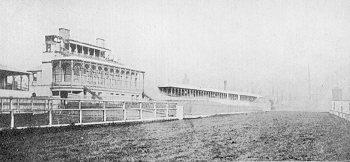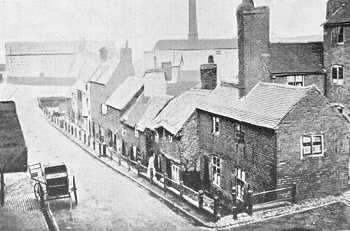The Old Racecourse and Canal Street The Grandstand of the Old Racecourse Our last November number contained a view of the old racecourse, but not showing the grandstand, a view of which we have now pleasure in presenting to our readers. There is no occasion to add to our previous remarks, to extent. As will be seen, the stand was a light and handsome building, and its destruction. was to be regretted. Probably had our local rulers foreseen the annual fetes, with the popular horse-leaping competitions, steps would have been taken to preserve the stand. As it is, a large and ugly wooden structure has to be erected every year at considerable expense. There are very few now living who can recall the race flood of 1831, when tents were blown down, booths washed away, and hundreds of people compelled to remain for some hours until the flood which surrounded them subsided, though several ladies were carried shoulder high through the flood on payment of half-a-crown.
It was customary at the period to which we refer to add to the attractions of the race week a series of cock fights of more than ordinary importance at the old cock-pit in Townwell Fold. A Battle Royal for 200 guineas on the main, and five guineas additional on each battle (that is between each pair of birds) came off during the race week in 1828, between the gentlemen of Staffordshire and the gentlemen of. Shropshire, a noted feeder named Evans, assisted. by Hadley, of Wednesfield, taking charge of the Shropshire birds, and Potter Partridge being in attendance on those belonging to the home county. There were three double days' play, the fighting commencing at eight each morning and lasting until noon, when there was a cessation of hostilities for the spectators to adjourn to the races; then when the last race had been run, the ticket holders would hurry back to the cock-pit, and the fights were resumed. On the occasion referred to, Staffordshire gained the victory by 15 mains and 10 byes, against Shropshire's 14 mains and 8 byes. There was a numerous attendance on each of the three days, and many hundreds of pounds changed hands. Cock-fighting, however, has long been tabooed by society as a cruel sport, and although occasionally indulged in secretly by colliers, is fast becoming but a remembrance of the past. Canal Street Canal Street of today presents a very different appearance to what it did at the time when the old cottages shown in our illustration, existed. The street has little of historical interest worth recording, unless it be that in years gone by it afforded accommodation for the overflow pig markets, then held in the centre of the town. Eighty years ago "The Admiral Vernon" was the best known and most frequented public in Canal Street, the landlord being Mr. Stirk, whose son was afterwards in business for many years as a maltster at Heath Town.
A close inspection of our, illustration will show "The Leather Bottle" sign opposite the stump about the middle of the row of cottages. On every occasion of a storm, the gulley being a cul-de-sac, was flooded, and the inhabitants had to seek dry quarters in the second storey. The cottages have disappeared, their site being now occupied by Shelton's timber yard. |





